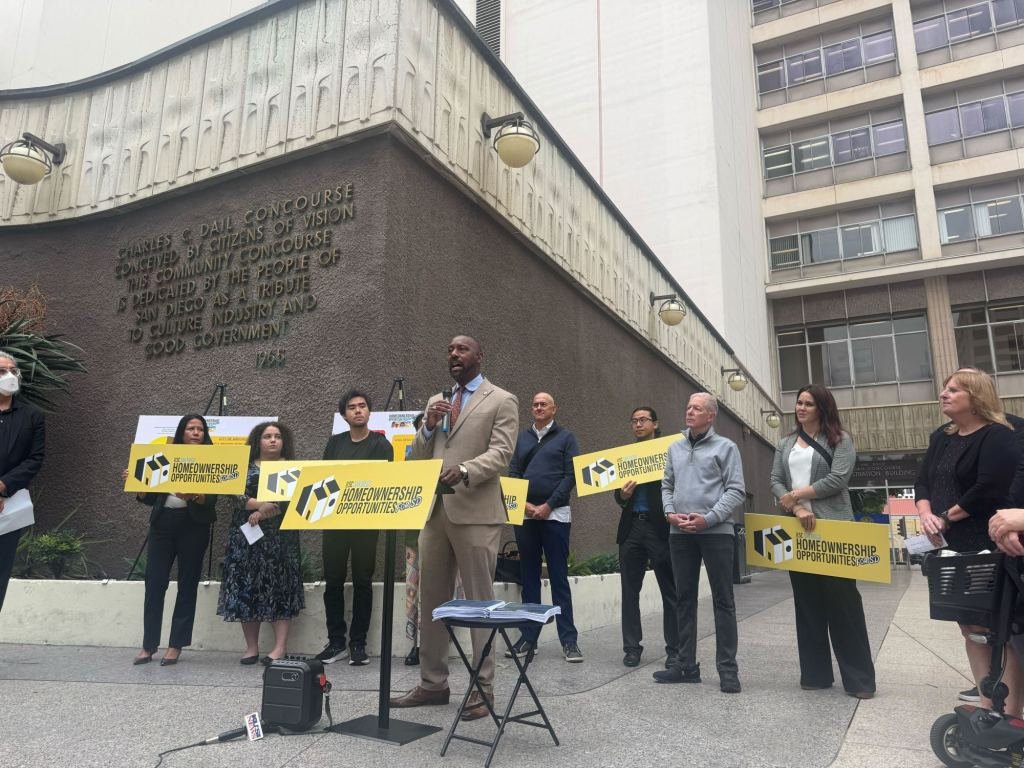Pro-housing advocates say the reduction of San Diego’s residential lot sizes could lower home prices, and increase tax revenue for the cash-strapped city.
As the morning sun cast a golden hue on downtown San Diego, a diverse coalition of housing advocates gathered to present a bold proposal that could reshape the city’s residential landscape. Armed with research from London Moeder Advisors, they argued passionately that reducing residential lot sizes—a holdover from 1923—could usher in a new era of affordability and sustainability for America’s Finest City.
Density and Affordability
In a city grappling with soaring home prices and an affordable housing crisis, reducing the minimum lot size from 5,000 square feet—enforced across 80% of San Diego—could prove transformative. “This isn’t just about housing; this is about creating stability and generating wealth for families,” declared Ricardo Flores, executive director of the Local Initiatives Support Corporation, as he spoke in front of City Hall. His passionate plea echoed the sentiments of many residents fed up with the status quo.
Historical Context and Proposed Changes
The existing lot size requirements, advocates argue, stifle innovation and limit the number of homes that can be built in fertile neighborhoods. Cities that have already embraced smaller lot sizes, like Houston, Texas, have witnessed increased housing supply and diversified neighborhoods. “Time and again, we’ve seen how nimble zoning laws foster economic development,” stated Gary London, a principal at London Moeder Advisors. “San Diego should no longer be an outlier.”
- Swapping expansive lawns for vertical living might seem radical, but it could lead to:
- More homes available at lower price points.
- Increased tax revenue stemming from higher property counts.
- A revitalized economy with residents spending less on housing and more in local businesses.
The report presented by London Moeder Advisors projected that if the city amended its zoning laws, San Diego could stand to gain between $10 million and $43 million annually from property taxes if 150 to 400 properties were developed. Should developers rise to the challenge of building 4,000 new homes in a year, the potential tax boost could surge to an astounding $430 million.
The Economic Argument
Flores highlighted that homeownership is the cornerstone of community wealth and stability. “It enriches families and strengthens neighborhoods,” he said, while showcasing plans for light density residential setups. “We aren’t proposing high-rises in family-centric areas; rather, think of townhomes or two- to three-story homes that fit within the existing aesthetic.”
Tax Implications and Community Impact
Estimates suggest there are significant tax benefits in diversifying San Diego’s housing inventory. Most of the city’s current homes rest on lots larger than the new proposed sizes, and this potential zoning shift is expected to alleviate the financial strain on many households. Nicole Lillie, head of the youth-led nonprofit Our Time to Act, voiced her concerns about the exodus of young people from the city, stating bluntly, “We’re losing our future taxpayers. Many of my friends are living in couches or cars simply because they cannot afford rent.”
“This is not merely about numbers,” Lillie said, “but about the stories behind them. Too many young households are squeezed out of the market.”
Balancing Community Concerns
To quell potential neighborhood opposition, the proposal strategically includes a parking requirement. “At least one parking spot should be required per new home,” suggested London, pointing out the increasing strain on street parking in many areas of San Diego. Furthermore, one of the critical stipulations of the revised proposal is to exclude subsidized housing, making it clear that the objective is to ensure the affordability of these new homes in a functioning market.
A Vision for the Future
Looking ahead, proponents are keen on showcasing successful designs likely to resonate with homeowners. The proposal suggests building two- or three-story homes maximizing vertical space without traditional backyards, akin to developments seen in places like Chula Vista’s Otay Ranch. This way, families can enjoy the benefits of homeownership without the burdensome maintenance of extensive private yard space.
“Imagine being able to walk down to the neighborhood café or park,” Flores mused as he wrapped up, envisioning community interactions that presaged a vibrant, interconnected environment. “This isn’t just policy; this is about our lives in San Diego.”
Legislative pathways are still uncertain; however, as dialogue grows around the proposal, it may well chart a course towards reshaping housing and community structures in a city rich with potential yet sorely lacking in affordable options.









